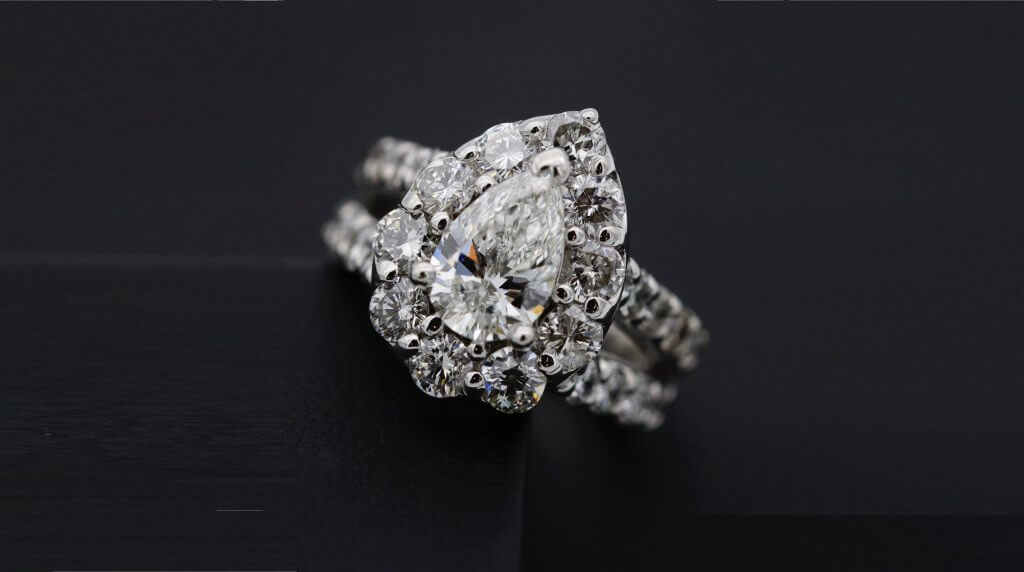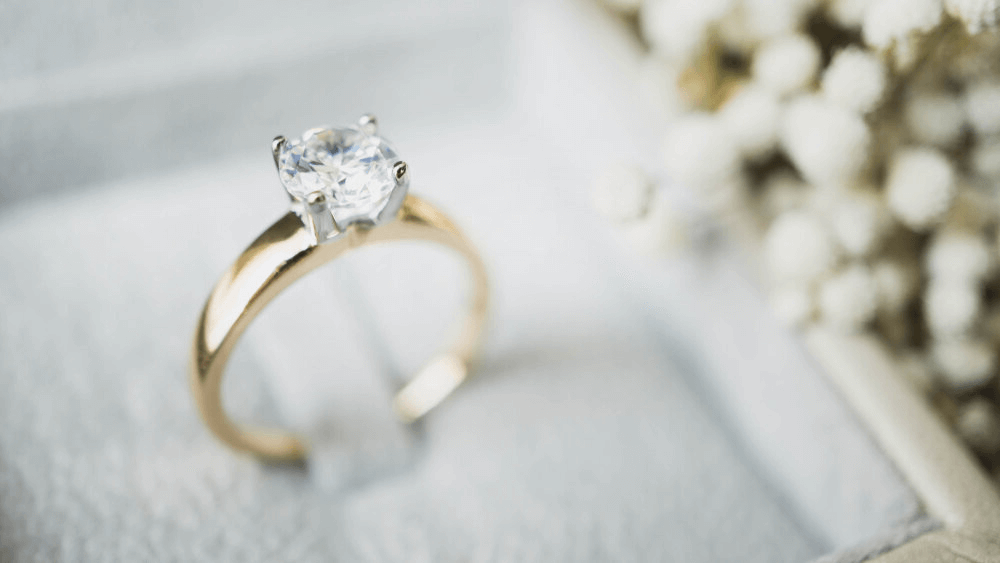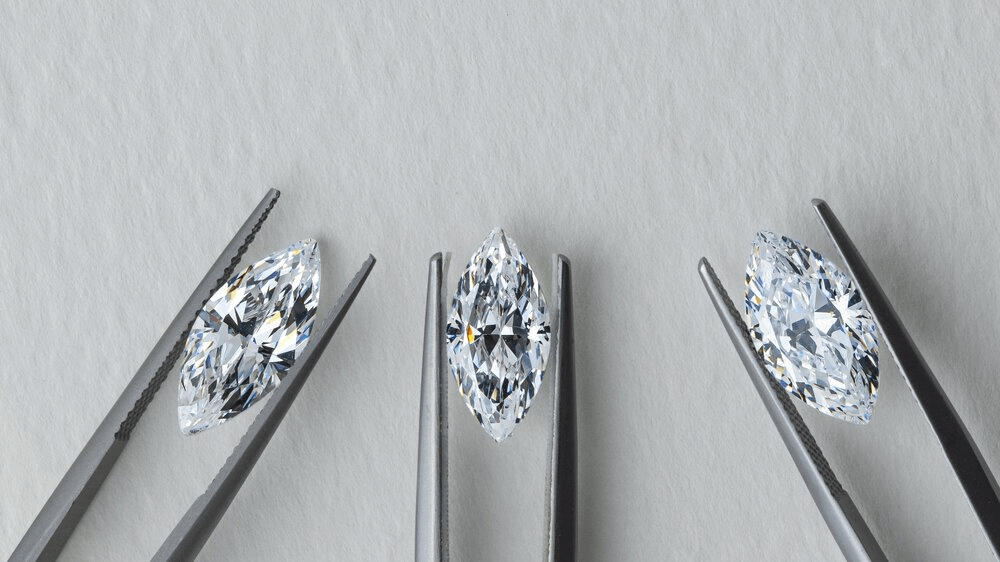Diamond Symmetry Grading: The Essential Information

By Gary A.

Edited by Olivia H.
Published Sep 18, 2021
Edited on Dec 18, 2024
When it comes to maximizing sparkle, diamond symmetry grading plays a crucial role— but is it the deciding factor for your perfect engagement ring? Let’s dive in!

Navigate This Guide:
- 7 Quick Tips for Evaluating Diamond Symmetry When Buying an Engagement Ring
- Introduction
- Understanding the Basics
- Grading Diamond Symmetry: A Critical Eye
- Symmetry vs Cut in Diamonds
- Symmetry vs Polish
- Our Expert Take
- 10 FAQs
Before we dive deeper into the specifics, here are some practical tips to help guide your decision-making process:
7 Quick Practical Tips for Evaluating Diamond Symmetry When Buying an Engagement Ring
- Tip 1: Know the Grades: Familiarize yourself with GIA’s symmetry grading scale – Excellent, Very Good, Good, Fair, and Poor. Aim for diamonds graded “Excellent” or “Very Good” in symmetry for the best light reflection and brilliance. Understand that the symmetry grade affects how light plays within the diamond. Higher symmetry grades ensure a more uniform and balanced reflection of light, enhancing the diamond’s sparkle.
- Tip 2: Check for Consistency: Examine the diamond carefully to ensure that the facets are consistently aligned. The facets should meet at precise points, and their sizes and shapes should be uniform. Use a jeweler’s loupe or a magnifying glass to get a closer look at the diamond’s facets. Check if the crown (top) and pavilion (bottom) facets align correctly.
- Tip 3: Centered Table and Culet: Ensure that the table (the flat top surface) and the culet (the point at the bottom) of the diamond are perfectly centered. An off-center table or culet can affect the symmetry and overall appearance. Look at the diamond from a top-down view. The table should be directly over the culet, forming a straight line down the center of the diamond.
- Tip 4: Girdle Consistency: The girdle (the outer edge where the top and bottom portions meet) should be consistent in thickness. Uneven girdle thickness can indicate poor symmetry and affect the diamond’s balance. Along with visual examination, feel the girdle with your fingertips (if allowed) to sense any unevenness in thickness.
- Tip 5: Shape Regularity: For round diamonds, ensure that the shape is perfectly round. For other shapes, like oval or marquise, check for balanced and symmetrical outlines. View the diamond from above and from the side to ensure the shape is uniform and symmetrical. Any deviation might indicate poor symmetry.
- Tip 6: Sparkle and Brilliance: Observe the diamond under different lighting conditions. A diamond with good symmetry should display consistent sparkle and brilliance throughout. Move the diamond under light and notice how light travels through it. Uneven light patterns can suggest symmetry issues.
- Tip 7: Leverage Technology: Utilize digital tools and high-resolution images available at many jewelers to examine the symmetry. Look for tools that provide magnified, 360-degree views of the diamond. Compare the diamond with others of similar grades using these tools. Digital imagery can highlight symmetry deviations more clearly than the naked eye.
Now that you’ve got these practical tips, use Jeweler AI below to find the perfect engagement ring that suits your style and budget:
Introduction
One of the first things we learn about diamonds is that they comprise many facets, and that, in any diamond, every single one of those facets has to fit perfectly alongside the next.
In other words, diamond cutting is about much more than shaping a rough stone into something beautiful enough to place on the fingers of the ones we love – it’s about creating something that sits as close to perfection as possible. After all, each diamond shape is the product of a complex system of geometry – one purposefully designed to bring out as much of the stone’s natural beauty as possible.
It’s a discipline that demands decades of study, so how can you make sure that your diamond is a good one? Alongside working with a reputable jeweler, you can learn the basics of Cut (that all-important first C of diamonds) and, in this article specifically, how symmetry impacts the strength of a diamond’s cut…
Understanding the Basics
As the name suggests, diamond symmetry refers to the balance between all sides of the diamonds – an even alignment between the diamond’s facets which, when done correctly, optimizes sparkle.
The diamonds we buy and set within jewelry are cut into very precise shapes – shapes which are formed by complex arrangements of facets, or ‘faces’ which alter the path light takes through the diamond. From the diamond table to the crown, girdle, pavilion and culet, everything needs to have been cut with the upmost precision in order to yield a strong result.
A diamond that is considered symmetrical is one that will have checked many boxes. Asymmetrical diamonds may have an off-center table or culet, wonky facets, or a crown that does not match up with the facets of the pavilion beneath, or a girdle that does not appear circular from above, or straight from the side. They might have an extra facet, or a table that does not sit level.
These days, it is much easier to find symmetrical diamonds than it used to be. Diamond cutters have a wide variety of advanced tools and technologies at their disposal, meaning that a much greater degree of precision can be reached. But, even with all that tech by their side, it is still a demanding art and one that, unfortunately, does not always work out.
Why Symmetry Matters in Diamonds
Symmetry is very important to a diamond’s sparkle and overall appearance, though it is generally thought to be slightly less pressing than table and depth percentage.
Cut proportions certainly have more of an impact on the diamond’s appearance than either symmetry or polish, but that’s not to say that you don’t need to worry about symmetry. In fact, diamonds with low symmetry grades can cause some pretty major issues for diamonds that would otherwise appear eye clean, and make it seem as though a diamond features an inclusion, even if it’s been graded as VVS (or higher).
Even so, there’s only a very minor difference between the top two symmetry grades, Excellent and Very Good, so provided you stick to these two grades, you certainly don’t need to get worked up over the question of symmetry.
Any slight errors in the diamond’s symmetry can also be disguised within the ring setting, too, so remember to keep the finished article in mind as you shop – and, obviously, to talk to your jeweler about any concerns. At WillYou.com, we only list diamonds with Excellent and Very Good symmetry grades, and a reputable jeweler will never encourage you toward a diamond with poor symmetry for the same reason.
Grading Diamond Symmetry: A Critical Eye
As with clarity and color, symmetry is graded via 10x magnification. A grade of ‘Excellent’ or ‘Very Good’ can only be achieved when the diamond’s visual appearance is unaffected, which is why we would never recommend going beyond these two grades – and only offer diamonds that appear symmetrically perfect to the naked eye.
We mentioned above the sorts of asymmetries from which a diamond can suffer, but it is worth remembering that a diamond may, of course, have more than one of these issues. In this case, the cumulative score will generally be lower than the individual flaws. If, for example, two minor asymmetrical features would each be given a grade of ‘Very Good’ then, combined, they may lead to a grade of ‘Good’.
Interpreting Symmetry Grades
The GIA uses the same scale that is used for many other aspects of cut quality, ranging from Excellent to Very Good, Good, Fair and Poor.
This grade will be included within your diamond’s GIA Report, alongside a grade for polish, a table percentage, a depth percentage, and a more general grade for cut.
The Link Between Symmetry and Hearts and Arrows Diamonds
That fascinating pattern of hearts and arrows within the internal structure of a diamond is created by precision cut round diamonds with excellent optical symmetry.
We look at the Hearts and Arrows diamond phenomenon in closer detail here but, for now, keep in mind that only the most symmetrical diamonds are able to achieve the clean, crisp lines of a true hearts and arrows diamond. Many diamonds can feature excellent cuts, with strong proportions and great brilliance, and still not feature the hearts and arrows – for that, a diamond requires an incredible degree of symmetry.

Symmetry vs Cut in Diamonds
Diamond symmetry is one of many factors that determine a diamond’s cut grade. Also considered are polish, depth, and table percentage.
Diamond cutting is incredibly complex. Transforming a rough stone into something that is precise and beautiful enough to be featured in a diamond engagement ring demands an incredible amount of skill – and some pretty remarkable technology – in order to pull it off well.
Diamond cutters have to work out the best cut to accommodate the diamond’s original size and dimensions, and to limit the presence of inclusions without losing any unnecessary weight, all while ensuring a strong level of symmetry between as many as 58 facets. When the aim is to create diamonds with excellent cut proportions, bright sparkle, no visible flaws and perfect symmetry, there are many things that can go wrong.
Nevertheless, the payoff for getting it right is more than worthwhile, particularly when that diamond is sitting pretty on your future bride’s finger.
Symmetry vs Polish
Symmetry, but only slightly. Both factors can have an impact on the diamond’s light performance, with significant asymmetries or polish features interrupting the natural path light takes in, through, and back out of a diamond.
Significant asymmetrical features (that is, asymmetrical features that impact the diamond’s appearance to the naked eye, rather than under 10x magnification) are definitely the worst of the two, but any visible flaws should always be avoided. In both cases, opting for those highest grades is by far your best bet, meaning that, at the end of the day, it’s not all that important to know which feature is more important than the other.
Symmetry is, however, particularly important in round cut diamonds, where accommodating those 58 facets (and achieving that perfect sparkle emblematic of the found brilliant cut) requires an extreme level of precision. For this reason, some jewelers recommend sticking to the ‘Excellent’ grade for round diamonds, but this is not always necessary.
Our Expert Take
While diamond symmetry needs to be a key consideration as you shop for a diamond, it does not need to be your primary focus. Other features have more of an impact on the overall appearance of a diamond but keep in mind that dipping below a certain point on the GIA scale for symmetry is a recipe for disaster.
Yes, it can be confusing for us to say ‘Symmetry is not the most important feature’ in one breath, and ‘Don’t dip below visual perfection’ in another, but trust us when we say finding that delicate balance will be more than worth the time it took in the long run.
So, yes, you do need to worry about diamond symmetry, but not as much as you need to worry about the stone’s overall cut grade or its table and depth percentages.
If you’re after a hearts and arrows diamonds, then symmetry is key but, if not, you can afford to cut yourself a little extra slack.
10 FAQs
- Q: What is Diamond Symmetry?
- A: Diamond symmetry refers to how well-proportioned and uniformly arranged the facets of a diamond are. It plays a crucial role in the diamond’s ability to reflect light and sparkle.
- Q: Why is Symmetry Important in a Diamond?
- A: Symmetry is important as it affects the diamond’s overall appearance and brilliance. Well-aligned facets ensure better light reflection, contributing to the sparkle and beauty of the diamond.
- Q: Can You See Diamond Symmetry with the Naked Eye?
- A: In most cases, minor symmetry imperfections are not visible to the naked eye. However, significant asymmetry can be noticed without magnification and may impact the diamond’s appearance.
- Q: What is the Best Symmetry Grade for a Diamond?
- A: The best symmetry grades are ‘Excellent’ and ‘Very Good’. These grades indicate that any symmetry deviations are minimal and do not significantly impact the diamond’s brilliance.
- Q: Does Poor Symmetry Affect a Diamond’s Value?
- A: Yes, poor symmetry can lower a diamond’s value as it detracts from the stone’s overall beauty and can impact its ability to reflect light effectively.
- Q: How is Diamond Symmetry Graded?
- A: Diamond symmetry is graded by gemological institutes like the GIA, using a scale that ranges from ‘Excellent’ to ‘Poor’. This grading is based on the precision of facet alignment and uniformity.
- Q: Can a Diamond Have Perfect Symmetry?
- A: While ‘Excellent’ symmetry is the highest grade, it does not necessarily mean the diamond is perfectly symmetrical. It indicates that any imperfections are insignificant and do not affect the diamond’s overall appearance.
- Q: Is Symmetry More Important than Cut or Clarity?
- A: Symmetry is one component of a diamond’s overall cut quality. While important, it should be considered alongside other factors like cut, color, and clarity for a comprehensive evaluation of the diamond’s quality.
- Q: How Do Jewelers Check for Symmetry?
- A: Jewelers use magnification tools like a jeweler’s loupe or microscope to examine the alignment and uniformity of a diamond’s facets, checking for any visible deviations in symmetry.
- Q: Should I Prioritize Symmetry When Buying a Diamond?
- A: While symmetry is important, it should be balanced with other aspects of the diamond, such as cut quality, color, and clarity. An excellent or very good symmetry grade is generally desirable.
Explore Jeweler AI for personalized guidance on diamond symmetry and find your perfect engagement ring match!
FOLLOW-UP GUIDE SERIES












